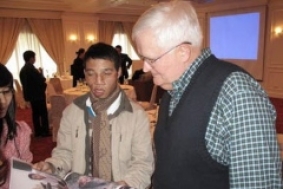
But Nguyen Duc Huynh, a 21-year-old whose face was disfigured by explosives, is attempting to make a difference to the lives of landmine victims.
Huynh at a meeting with Vietnam War veterans from the US - Photo: Tuoi Tre
“My name is Nguyen Duc Huynh. Let me tell you the story of my life, the story of a landmine victim in the post-Vietnam War period,” he says.
He recalls the fateful day in 1994 when he and his twin brother, Hoa, stopped by a workshop that recycled unexploded bombs in his hometown in central Quang Tri Province.
An explosion took place.
“I didn’t know what happened around me, the only thing I remember is hearing people’s cries and the footsteps of people fleeing the scene.”
The brothers were admitted to a hospital where Hoa escaped with minor injuries. But Huynh was in a critical condition.
He was in a coma for a week and came to only to find his face ravaged and body covered in scars.
“I had a hard time eating because the rice kept falling out of my mouth,” he recollects about the immediate aftermath. “Since I could not close my eyes to sleep, tears kept flowing.”
A Swedish filmmaker named Fokle Rydén heard about the young boy’s fate while visiting Hanoi in 1996.
Rydén decided to head for Quang Tri to make a documentary on Huynh which was later broadcast in Sweden.
Moved by the boy’s story, Goran Avinius, a Swedish businessman, donated money to fund a surgery to repair Huynh’s face.
But Avinius was not happy with the result of the first operation in Hanoi and sought more assistance from philanthropists in the US.
His efforts were successful and Huynh underwent seven more surgeries in Boston, the US, starting in 1999 which gradually helped put his face back together.
“They were intolerably painful,” the young man says about his experiences with the scalpel.
Scar boy
But Huynh’s face remained badly scarred and it proved to be a millstone around the neck of a growing boy. He started to become aware of his physical inferiority and earned the nickname “scar boy” when he returned to school.
Huynh became increasingly conscious of his appearance as he entered his teens and noticed the shocked response of people who saw him on the street.
Form being an overachiever at school, he began to lose focus on his studies and ended up quitting altogether.
He hoped to enroll at a vocational school but walked out after overhearing the school staff referring to his application as “an impossible case.”
The rejection persuaded Huynh to return to school and later enroll at a college in Hanoi.
When he tried to find a part-time job to support himself while studying in the capital, he again faced rejection. Huynh says people rejected him after the very first meeting though he was otherwise qualified.
He also got used to being chased off at restaurants and coffee shops that mistook him for a beggar.
Website for landmine victims
His experiences prompted Huynh to think of thousands of other landmine victims in the country, inspiring him to create a website to raise public awareness about their heart-rending plight.
To find material for www.nannhanbommin.com, he often visits his hometown in Quang Tri, one of the unexploded-ordnances hotspots, to record victims’ stories.
He also speaks to Vietnam War veterans from the US to apprise them about the aftermath of the war in Vietnam.
Huynh mostly funds the cost of running the website himself despite struggling to find a part-time job.
“Sometimes I receive donations from acquaintances in the US,” he said. “Most of the time I use my own money … by sacrificing some other needs. But I’m not sure how long I can continue like this.”
He is planning to give a younger landmine victim VND500,000 (US$27) from his pocket but admits it is not a good idea. “Giving landmine victims money is not the best way to help them. Money gives them no direction in life.”
Some non-governmental organizations provide aid to victims, but only focus on healthcare and treatment instead of providing them vocational training and employment opportunities to allow them to lead a self-reliant life, he says.
He is concerned about helping fellow victims and finding ways to stop the explosions so that no one else has to suffer his fate.
“Please spread my story to your friends around the world,” he says.
According to the Ministry of Defense, landmines and unexploded bombs are scattered over nearly 6.6 million hectares, or 20.12 percent of the country’s land area, and it is estimated Vietnam would need at least 300 years and $10 billion to clear them.
Since the end of the war in 1975, more than 100,000 people have been killed or injured by landmines, bombs, artillery shells, grenades, and a variety of other explosives.
In Quang Tri alone, the toll has been more than 7,000, or 1.2 percent of the province’s population.
Tuoi Tre






